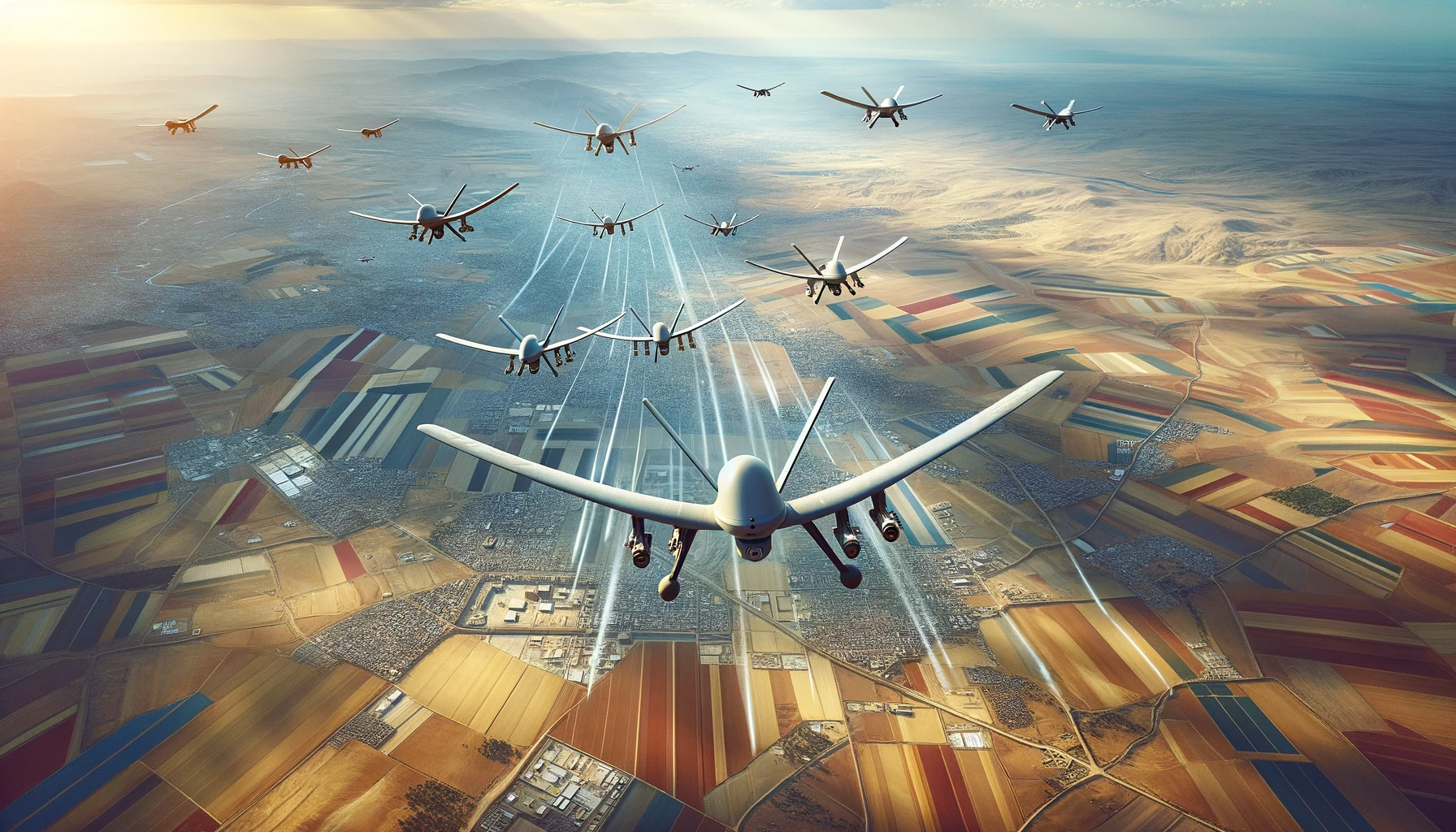In a paper published in the journal Sensors, researchers addressed challenges faced by Unmanned Aerial Vehicle (UAV) clusters in three-dimensional space during area coverage tasks. The proposed strategy for mission planning included the analysis of the area coverage search task, determination of the coverage scheme, and subdivision of the cluster task area into subareas.
 Study: Enhancing Efficiency in Three-Dimensional UAV Cluster Area Coverage. Image credit: Generated using DALL.E.3
Study: Enhancing Efficiency in Three-Dimensional UAV Cluster Area Coverage. Image credit: Generated using DALL.E.3
The researchers proposed a step-by-step solution for allocating tasks to UAV clusters, incorporating an improved Fuzzy C-clustering algorithm. They also introduced an optimized algorithm called Particle Swarm Hybrid Ant Colony (PSOHAC) for UAV cluster task path planning. Simulation experiments confirmed the feasibility and superiority of the proposed scheme, showcasing efficient task allocation, full task area coverage, and significant enhancement in balanced energy consumption efficiency for UAV cluster task search planning compared to related algorithms.
Background
The evolution of UAV technology has expanded its role in diverse tasks, including plant protection and forest fire prevention. UAVs, known for their flexibility and efficiency, overcome challenges in harsh environments, reducing labor costs. Using multiple drones, forming clusters or swarms, addresses task complexity.
Past research focused on optimizing UAV cluster tasks, load balance, and trajectory planning using mathematical models and swarm intelligence. As the field advances with larger clusters and varied terrains, the emphasis shifts to designing efficient task allocation algorithms, especially for complete coverage tasks in three-dimensional space, acknowledging factors like altitude and wind speed to meet the growing computational demands.
Study Focus and Model Establishment
The study focuses on rotary-wing UAVs, highlighting their superior maneuverability compared to fixed-wing counterparts. It underscores their effectiveness in optimizing task planning and allocation for area coverage operations. It also concentrates on complete coverage tasks, such as target search and forest fire inspection. It examines the application of multiple UAVs forming clusters by assuming a constructed task area map and a 3D coordinate system for accurate calibration. It proceeds to establish models for UAV search area coverage, division of task areas for UAV clusters, path planning, and an energy efficiency model for the entire UAV cluster.
In the model establishment section, the paper details the coverage model for UAV search areas, considering cone-based detection methods, and introduces a method for dividing the task area efficiently for UAV clusters. The path planning model optimizes UAV trajectories to minimize overlap, considering efficiency metrics based on repeated coverage areas and energy consumption. The energy efficiency model evaluates the UAV cluster's overall and balanced energy efficiency, providing a comprehensive algorithm performance assessment.
UAV Cluster Search Task Design
Cluster Task Area Planning: The algorithm divides the UAV cluster's task area using an enhanced fuzzy C-means method (O-FCM), overcoming traditional clustering challenges. A hexagonal pattern optimizes node classification, ensuring efficient coverage with minimal overlap.
Trajectory Planning: The trajectory planning process utilizes an optimized PSOHAC approach. PSOHAC addresses convergence issues by integrating dynamic pheromone calculation and filtering mechanisms. The algorithm also employs a niche particle swarm to categorize individuals, enhancing convergence speed and optimizing UAV cluster trajectory planning.
Simulation Analysis and Experimental Results
In this simulation analysis, the study employs an optimized fuzzy C-means clustering algorithm and an optimized particle swarm algorithm combined with the ant colony algorithm for task allocation in the full coverage search of UAV clusters within a specified area. Researchers carefully choose the algorithm parameters for the experimentation process. The simulation is conducted over a 1 km × 1 km horizontal range with a height range of 0 to 100 m, using a 3D mountain model to represent the terrain.
The initial experiments focus on evaluating the energy consumption efficiency concerning the number of UAVs employed for the search operation. Notably, the results indicate that eight UAVs achieve optimal energy consumption efficiency. Subsequently, the improved fuzzy C-means clustering algorithm successfully allocates tasks to UAV clusters, presenting spatial clustering results in both 3D and 2D views.
Researchers employ the PSOHAC algorithm to execute UAV trajectory planning, resulting in smooth trajectories without intersections. The fitness values for each UAV indicate a maximum difference of 14% and an average difference of 9%, affirming the feasibility and effectiveness of the proposed approach.
The study conducts comparative experiments to demonstrate that the proposed algorithms are superior to traditional algorithms. The PSOHAC algorithm exhibits faster convergence speed and higher optimization accuracy than other algorithms, as evidenced by the results. Further comparative testing underscores the method's advantages, including higher balanced energy consumption efficiency, lower total task quantity, and reduced UAV trajectory lengths while ensuring complete coverage of the task area.
Conclusion
In summary, this paper addresses energy consumption and task efficiency issues in UAV cluster missions, proposing an improved fuzzy C-clustering method for task division and a strategy combining particle swarm optimization with ant colony optimization for trajectory planning. Simulation results show successful task allocation and trajectory planning, with improvements in optimization accuracy and convergence speed. The proposed approach significantly enhances the balanced energy consumption and overall energy efficiency of UAV cluster tasks. Researchers will make future adjustments through real-world testing, acknowledging potential deviations between simulations and scenarios.